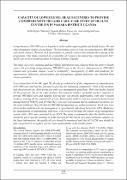| dc.contributor.author | Nakiwala, Stella Regina | |
| dc.date.accessioned | 2019-11-04T09:17:59Z | |
| dc.date.available | 2019-11-04T09:17:59Z | |
| dc.date.issued | 2009-12-01 | |
| dc.identifier.citation | Nakiwala, S.R., 2009. Capacity of lower level health centres to provide comprehensive HIV/AIDS care: case study of health centre IVS in Masaka district, Uganda. Health Policy and Development, 7(3), p. 148-161. | en_US |
| dc.identifier.uri | http://hdl.handle.net/20.500.12280/2451 | |
| dc.description.abstract | Comprehensive HIV/AIDS care in Uganda is delivered through hospitals and health Centre IVs and other designated centres of excellence. The government aims to scale-up comprehensive HIV/AIDS care in the country. However, lack of resources to provide services has delayed the scale-up of the programme. This study examined the availability of resources for delivering comprehensive HIV/ AIDS care in lower health facilities in Masaka District, Uganda.
The study was cross-sectional and descriptive. Information was collected from the entire 8-health centre IVs providing comprehensive HIV/AIDS care in the district. Information on HIV/AIDS related care provided, human resource availability, management of ARVs and medicine for opportunistic infections, infrastructure and management support functions was obtained from service providers.
It was found that all the HC eight IVs already provided most of the components of comprehensive HIV/AIDS care and had the potential to provide the remaining components. Most of the facilities had the protocols for client protection and case management guidelines. Only one facility lacked all the protocols. Six of the eight facilities had optimal numbers of health workers required to provide HIV/AIDS care and support. One facility was grossly understaffed, with only 3 health workers covering all the components of care. Most health workers were not trained in home-based management of PLWHA and felt that they were overworked and had no additional incentives for the extra workload. They felt that the HIV/AIDS programme was under-resourced. Stock-outs were observed for medicines for the management of opportunistic infections but not for ARVs. Medicines for management of opportunistic infections were received through the routine drug management system while ARVs were provided by an NGO. The study recommended that the health workers should be given specific training in fields relevant for HIV/AIDS care and continuous updates on the latest information, the quality of care should be monitored and that HIV/AIDS care should be fully integrated to strengthen and increase sustainability of the health system. | en_US |
| dc.language.iso | en | en_US |
| dc.publisher | Uganda Martyrs University Press | en_US |
| dc.relation.ispartofseries | Health Policy and Development;volume 7 number 3 | |
| dc.subject | Capacity | en_US |
| dc.subject | Lower level health centres | en_US |
| dc.subject | Comprehensive HIV/AIDS care | en_US |
| dc.title | Capacity of lower level health centres to provide comprehensive HIV/AIDS care: | en_US |
| dc.title.alternative | case study of health centre IVS in Masaka district, Uganda | en_US |
| dc.type | Article | en_US |


